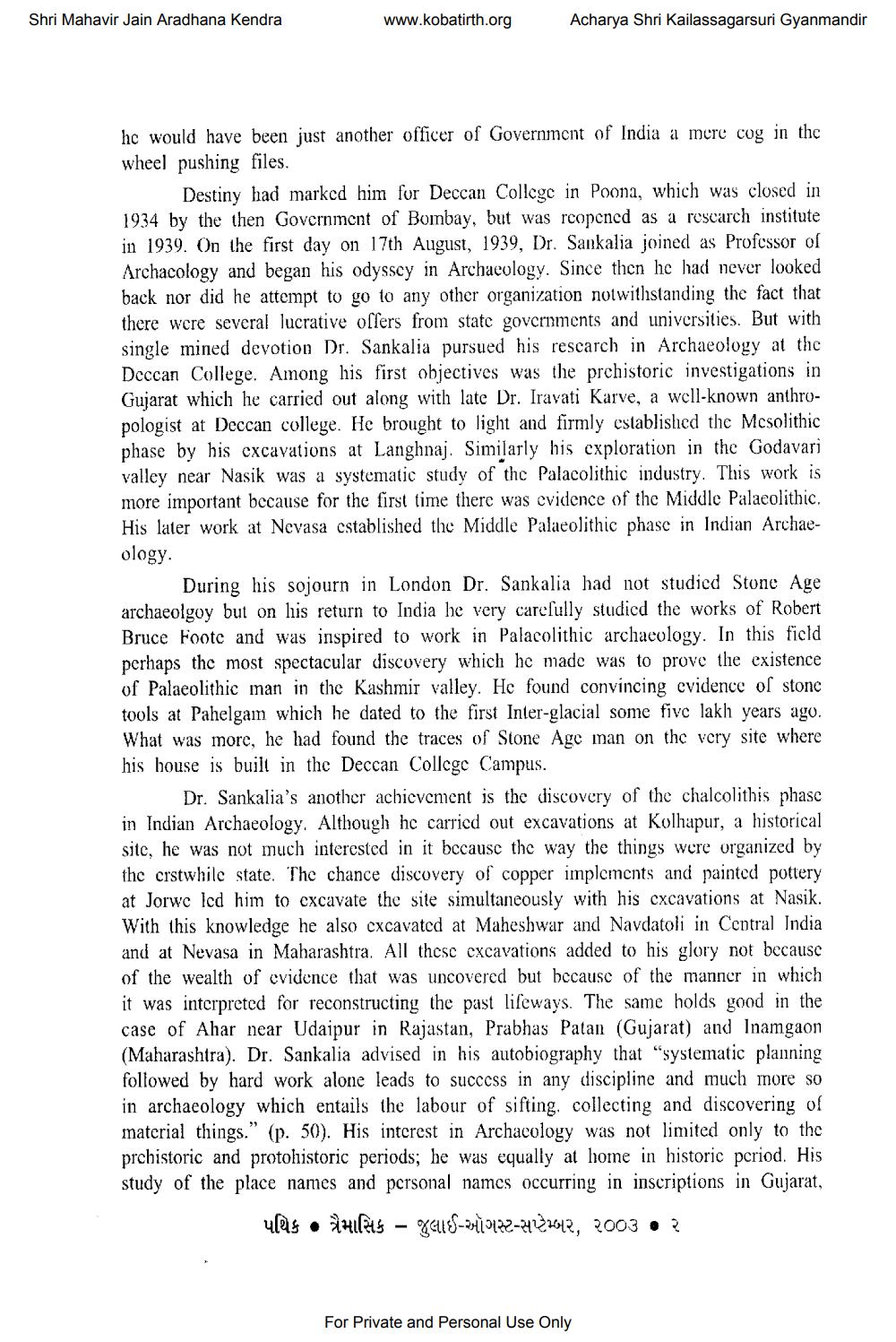________________
Shri Mahavir Jain Aradhana Kendra
www.kobatirth.org
Acharya Shri Kailassagarsuri Gyanmandir
he would have been just another officer of Government of India a mere cog in the wheel pushing files.
Destiny had marked him for Deccan College in Poona, which was closed in 1934 by the then Government of Bombay, but was reopened as a research institute in 1939. On the first day on 17th August, 1939, Dr. Sankalia joined as Professor of Archacology and began his odyssey in Archaeology. Since then he had never looked back nor did he attempt to go to any other organization notwithstanding the fact that there were several lucrative offers from state governments and universities. But with single mined devotion Dr. Sankalia pursued his research in Archaeology at the Deccan College. Among his first objectives was the prehistoric investigations in Gujarat which he carried out along with late Dr. Iravati Karve, a well-known anthropologist at Deccan college. He brought to light and firmly established the Mesolithic phase by his excavations at Langhnaj. Similarly his exploration in the Godavari valley near Nasik was a systematic study of the Palacolithic industry. This work is more important because for the first time there was evidence of the Middle Palaeolithic. His later work at Nevasa established the Middle Palaeolithic phase in Indian Archaeology.
During his sojourn in London Dr. Sankalia had not studied Stone Age archaeolgoy but on his return to India he very carefully studied the works of Robert Bruce Foote and was inspired to work in Palacolithic archaeology. In this field perhaps the most spectacular discovery which he made was to prove the existence of Palaeolithic man in the Kashmir valley. He found convincing evidence of stone tools at Pahelgam which he dated to the first Inter-glacial some five lakh years ago. What was more, he had found the traces of Stone Age man on the very site where his house is built in the Deccan College Campus.
Dr. Sankalia's another achievement is the discovery of the chalcolithis phase in Indian Archaeology. Although he carried out excavations at Kolhapur, a historical site, he was not much interested in it because the way the things were organized by the erstwhile state. The chance discovery of copper implements and painted pottery at Jorwe led him to excavate the site simultaneously with his excavations at Nasik. With this knowledge he also excavated at Maheshwar and Navdatoli in Central India and at Nevasa in Maharashtra. All these excavations added to his glory not because of the wealth of evidence that was uncovered but because of the manner in which it was interpreted for reconstructing the past lifeways. The same holds good in the case of Ahar near Udaipur in Rajastan, Prabhas Patan (Gujarat) and Inamgaon (Maharashtra). Dr. Sankalia advised in his autobiography that "systematic planning followed by hard work alone leads to success in any discipline and much more so in archaeology which entails the labour of sifting, collecting and discovering of material things." (p. 50). His interest in Archacology was not limited only to the prehistoric and protohistoric periods; he was equally at home in historic period. His study of the place names and personal names occurring in inscriptions in Gujarat,
પથિક ♦ ત્રૈમાસિક – જુલાઈ-ઑગસ્ટ-સપ્ટેમ્બર, ૨૦૦૩ ૦ ૨
For Private and Personal Use Only




